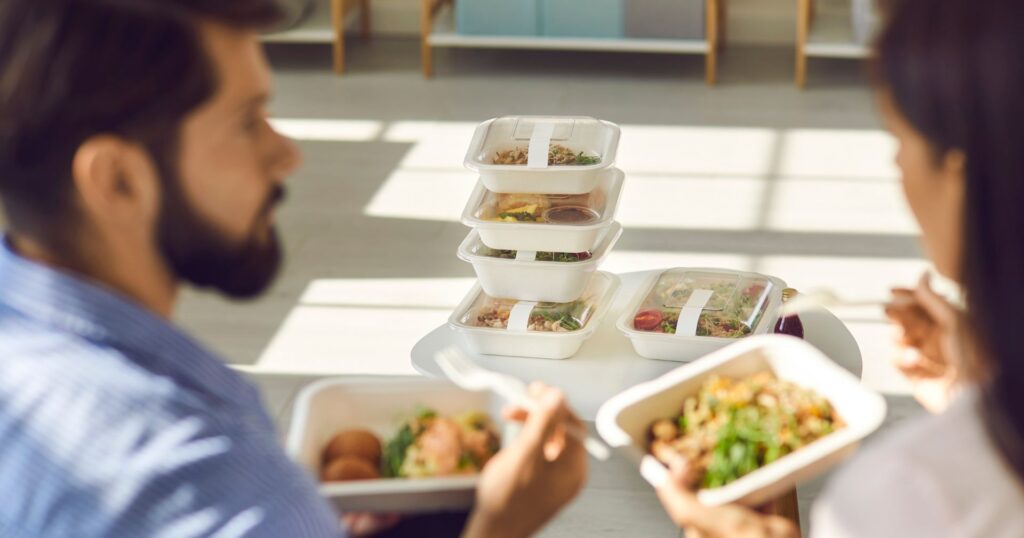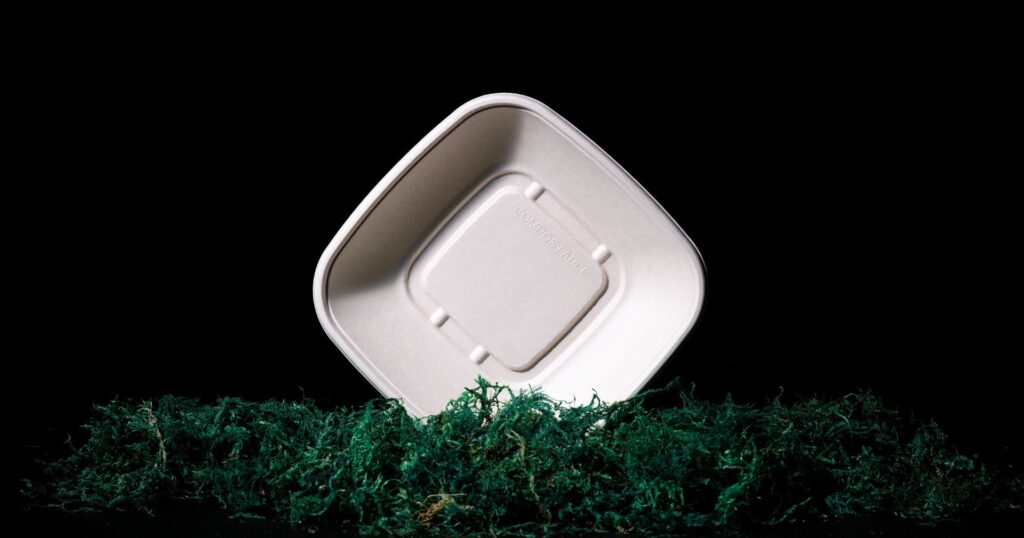The rise in demand for takeout and delivery brings into question the impact of single-use plastics. With governments implementing plastic bans across the globe, businesses are faced with two choices: a reusable takeout container or compostable takeout container.
But which is the most eco-friendly option? With a keen focus on the pros, cons, and long-term impacts, let’s take a look at which option is the most eco-friendly.
In this article:
- The Reusable Takeout Container Model
- The Compostable Takeout Container Model
- Comparison of Lifecycle Impacts

The Reusable Takeout Container Model
Reusable takeout container programs provide an alternative to the single-use plastic products commonly used in the food service industry. These containers are predominantly made from #5 plastic (polypropylene), which is a durable, long-lasting plastic.
These programs work by providing restaurants with reusable plastic containers, which they’ll then use for packaging takeout and delivery orders.
After the customer enjoys their meal, instead of tossing the container into a bin, they’re meant to responsibly return it. Companies that provide these containers have designated drop-off points for convenience, often in the restaurants consumers got them from.
Finally, the reusable company collects the used containers to sanitize them. Once clean, they return the containers to the restaurants, restarting the cycle.
The reusable takeout container model turns the traditional concept of disposable takeout containers on its head, favouring a return and reuse strategy.
Learn More: Composting vs Recycling: Which is better for the environment?
Benefits of Reusable Takeout Containers
Reduction of Waste
Every time a reusable takeout container completes another cycle, one less single-use plastic item ends its journey in a landfill, contributing to overall waste reduction.
Promotion of Sustainable Practices
The active participation in the reusable takeout container model fosters an ethos of sustainability and responsibility. Customers engage in deliberate action to protect the environment, creating a culture of sustainable everyday practices.
Cost-Efficacy in the Long Run
Despite an initial investment, the reusable takeout container program implies reuse over a significant period of time. The cumulative cost implications could see restaurants saving money in the long run.
Drawbacks of Plastic Reusable Takeout Containers
Microplastics and Degradation
While #5 plastic is durable, repeated use and washing can release microplastics into food items and the environment. Over time, containers may degrade or break, necessitating their replacement and impacting long-term viability.
Dependency on Consumer Behaviour
The success of the reusable takeout container program largely hinges on consumers reliably returning the containers for sanitation and reuse. Bringing the containers to a drop-off location is an extra step in the consumer’s journey, and habit change on this scale can be challenging to achieve.
Worry of Improper Recycling
If consumers don’t return their reusable containers, they’ll either reuse them at home or recycle them. But if recyclable materials are contaminated by food waste, the containers could find their way to landfill.
Logistical Complications
The logistics (collection, sanitization, and redistribution of containers), can complicate restaurant operations. This could potentially increase overhead costs and decrease efficiency, particularly for smaller businesses.

The Compostable Takeout Container Model
Constructed with materials such as paper, bagasse, or wood, compostable takeout containers are designed for single-use followed by decomposition in either a home compost or commercial facility.
Manufacturers create these containers from renewable, earth-friendly materials. The process uses significantly less energy and water than the production of traditional plastic products.
Once restaurants pack the orders and the consumer enjoys their meal, the container starts its journey toward degradation. This is where compostable takeout containers take a stark departure from the reusable model. There is no pressure on consumers to return the container. Their only job is to toss it in their green bin.
In a home compost or commercial facility, these containers break down into nutrient-rich compost, often in a handful of months. That compost can then enrich agricultural soil, closing the loop on the container’s life cycle in an environmentally conscious way.
Learn More: Home Composting vs Commercial Composting: What’s the difference?
Benefits of Compostable Takeout Containers
Waste Diversion from Landfills
Properly composted, these containers convert into nutrient-rich compost, diverting waste from overloaded landfills and reducing methane, a potent greenhouse gas usually produced when organic matter decomposes in landfills.
Renewable Resources
Compostable containers are made from renewable resources such as plant fibres. These renewable resources can be regrown strictly for the purpose of manufacturing these containers. This reduces reliance on fossil fuels in production and competition for valuable resources.
Ease of Use for Consumers
The compostable takeout container model is simplified for consumers. They simply dispose of these containers in a green bin after use, with no worries of having to return them to the restaurant. This reduces the reliance on consumer behaviour and compliance for successful implementation.
No Microplastic Concerns
Since compostable takeout containers decompose fully under the right conditions, they pose no risk of microplastic contamination.
Soil Enrichment
When composted effectively, compostable containers re-enter the earth as nutrient-rich compost, positively contributing to soil health. This soil can then regrow healthy, renewable resources, aligning with the principles of a circular economy.
Drawbacks of Compostable Takeout Containers
Inadequate Disposal
To fully reap the benefits of compostable takeout containers, it’s necessary to dispose of them correctly. Without proper education and labelling, these items might end up in landfill, where they can take longer to degrade.
Short Lifespan
Compostable products have a shorter shelf life than their plastic counterparts. When restaurants are buying in bulk, they need to keep in mind that most compostable takeout containers have a two to three year shelf life.
Production and Transport Emissions
Though the production of compostable containers generally uses less energy and water than plastic, there are still emissions associated with manufacturing and transportation.

Comparison of Lifecycle Impacts
Exploring the lifecycle impacts of both the reusable and compostable takeout container models allows for a thorough comparison of their respective environmental effects.
Production
- Producing reusable takeout containers is energy-intensive due to the use of #5 plastic, which requires significant power to manufacture.
- Meanwhile, compostable takeout containers have a smaller carbon and water footprint in their production, especially as plant-based fibres can rapidly regrow.
Usage
- #5 reusable containers can be reused until they show signs of wear, thus drastically reducing the per-use environmental impact.
- Compostable containers are single-use, but return to the environment as they degrade in compost.
Disposal
- #5 plastic will degrade over time, potentially releasing harmful microplastics which contributes to long-term environmental harm.
- Compostable containers can decompose in less than a year, leaving no trace behind. If they aren’t composted properly and end up in landfill, containers will take longer to degrade.

Making the Sustainable Choice
Aligning our actions with the principles of sustainability involves discerning choices. In the context of takeout containers, while both reusable and compostable models have their merits, compostable containers present a compelling case for being the better option.
Compostable takeout containers offer numerous sustainable advantages. Compared to plastic, even the reusable kind, compostable containers significantly reduce the overall carbon footprint. Made from renewable resources, they skip the high-energy demands of plastic production.
After effective decomposition, these containers turn into nourishing compost, diverting waste from our landfills. Meanwhile, even though plastic is recyclable, it often ends up in landfill due to contaminated streams from unwashed containers.
Lastly, the user-friendly nature of compostable containers can foster broader acceptance of sustainable practices, thus making an eco-friendly impact at scale. Easy to dispose, compostable takeout containers stand as a viable and eco-conscious solution in the takeout industry.
Learn More: 5 Innovative Sustainable Products for Restaurants



